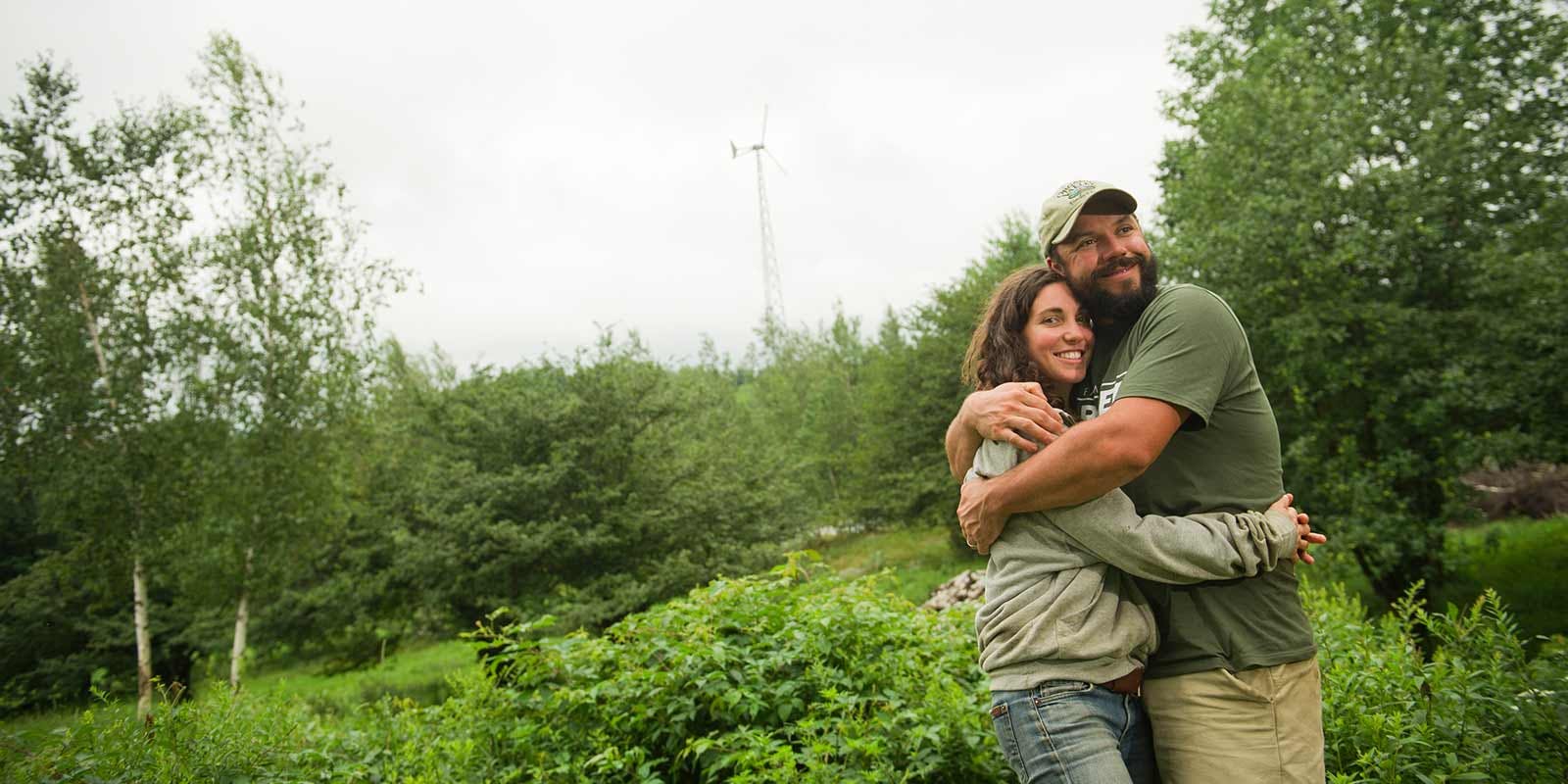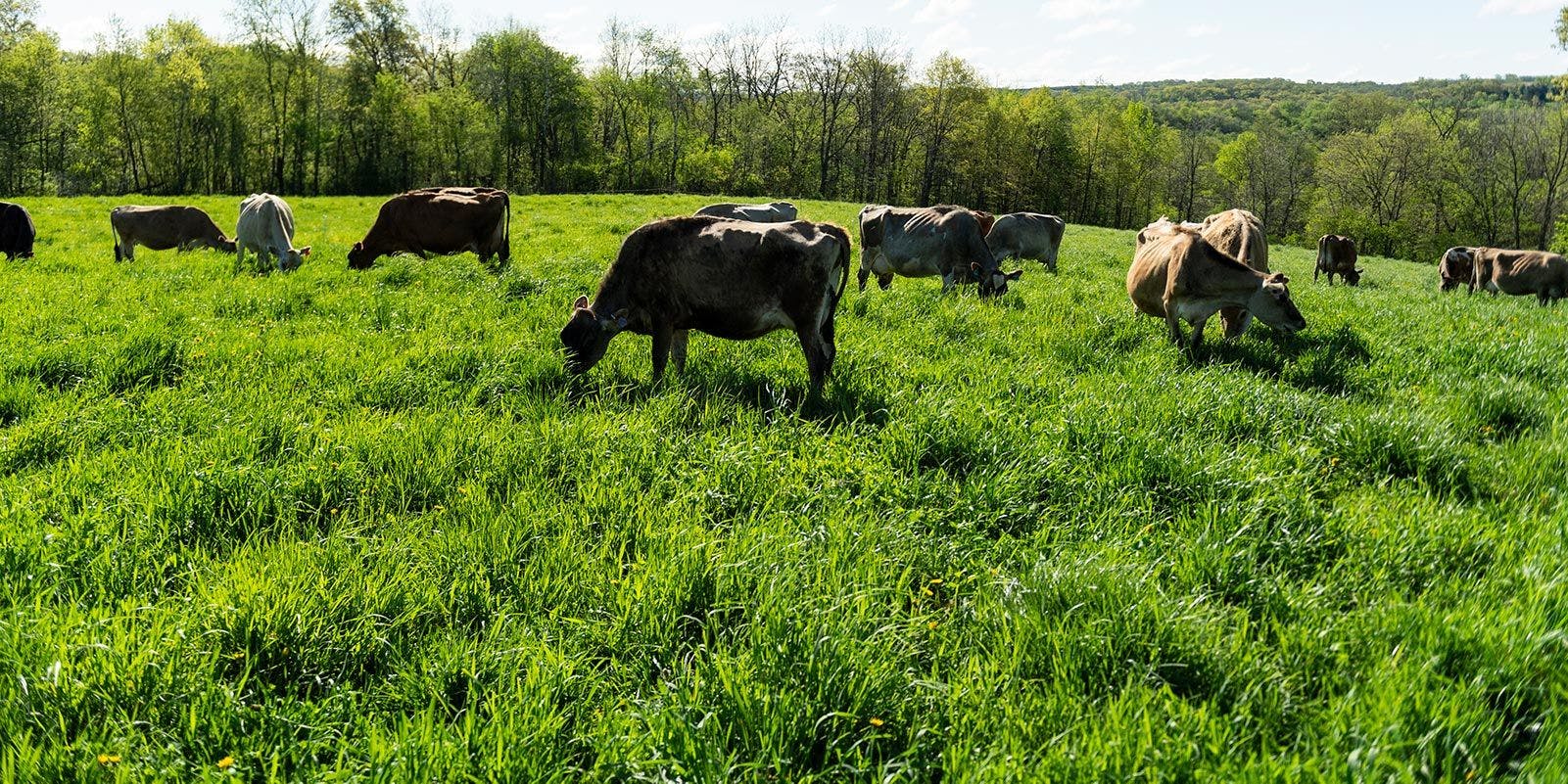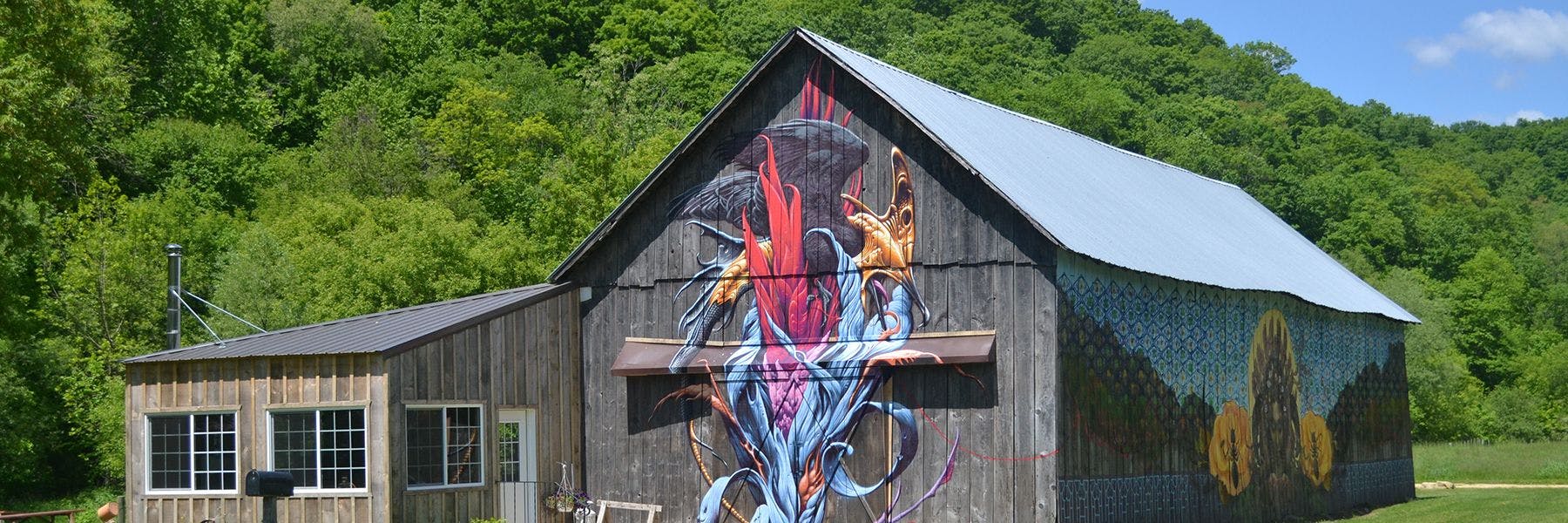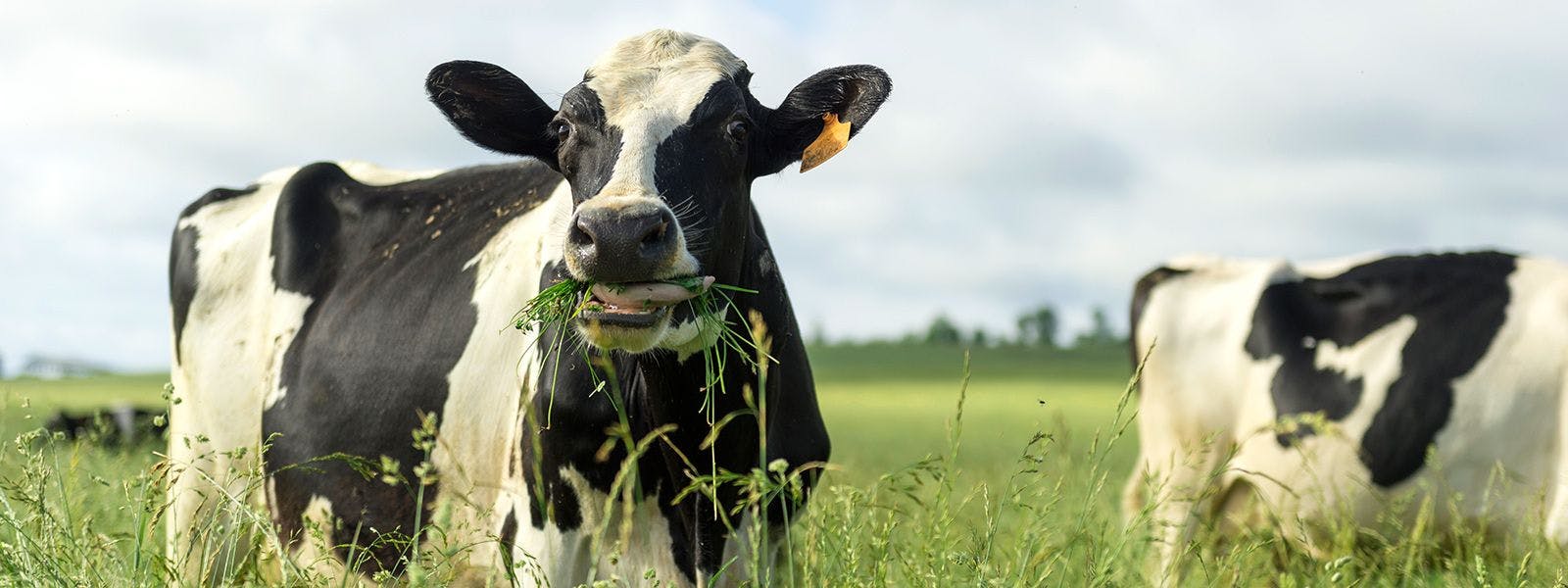
Earth
How Climate Change is Challenging Our Farms, and How Organic Makes a Difference
Climate change is already affecting farmers in profound ways. The slow changes are notable; even non-farmers can remember when snow used to fall before Thanksgiving or having to bundle up for trick-or-treating because it was already near freezing, yet both rarely happen now. But when your livelihood depends on friendly weather, the stakes are a lot higher.
There will be no silver bullet policies, no prescriptive models for peak efficiency that can deal with all the punches climate change might throw. Instead, we must rely on a farmer’s resourcefulness and the land’s resilience. Fortunately, those are two areas where Organic Valley farmers excel. As dairy farmer Tucker Gretebeck of Cashton, Wisconsin, put it, “Resiliency is part of what we do. It's built into our farming DNA.”
Setting the Stage
We’re already in the warmest period modern civilization has faced. The global average temperature has risen by nearly 2 degrees Fahrenheit in the last 120 years, and the five hottest years on record occurred in the last five years. While the global average temperature is certainly rising—largely driven by significant increases in the polar regions—the old maxim of “global warming” is being replaced by a recognition of “climate change” that allows for more climate nuances from region to region, which can have a cascade of effects.
In the U.S., one of the biggest influences on our extreme weather fluctuations is the jet stream, a powerful air current that normally keeps cold arctic air separate from warmer southern air. As the differences in temperature between the Arctic and the equator grow smaller, the jet stream weakens, allowing it to swing up and down more significantly over the northern U.S. So while winters are generally becoming warmer, we’re also seeing more polar vortexes that bring bitter temperatures. On farms, these extreme cold spells can kill off pasture grasses that used to survive just fine.
Another prominent effect can be seen with extreme rainfall events, increasingly common as the air warms and is able to hold more moisture. While some farmers battle 100- and 500-year floods, others face unprecedented drought and fires as the warmer air causes earlier spring melts and reduced snowpack. Indeed, if the effects of climate change were more predictable, it might be an easier pill to swallow—but they aren’t.
From Flood to Future
With his comment about resiliency above, Gretebeck hit on a recurrent hopeful theme in the discussions I had with Organic Valley farmers as I worked my way (virtually) across the country, from Oregon to Wisconsin to North Carolina, listening to horror stories of extreme weather events that tracked surprisingly closely with the best predictions our nation’s climate scientists have to offer.
Gretebeck described the aftermath of a 2018 deluge that dumped more than 10 inches of rain within 24 hours, bursting a dam in the valley above his farm. The family’s pumpkin patch agritourism operation disappeared overnight. Water swept away a beautifully painted barn, and tractors were swept down the valley and buried in debris. “It’s like building a sandcastle out here the last 10 years,” he said.
His son, Trent, was 8 at the time. “His head just dropped. It was sad. That was all the kids knew,” Gretebeck said. “It was like going to the fair every weekend; they couldn’t wait for pumpkin patch time.” But always one to look on the bright side, he continued, “Resiliency is one thing I wanted to teach them. It’s bad, but we’re gonna come up with something new.”
Gretebeck is still looking toward the future. “By the time our great-grandkids get here, what’s going to be left?” When Organic Valley asked him if he’d be willing to switch to 100% grass-fed dairy farming, “that was like a dream come true.”
Gretebeck sees himself as one of the lucky ones, describing how their grass-based production system improved their farm’s resilience. He knew it was a good transition right away. “When the calves start looking happier and the vet bills are going down, you’re doing something right.”
Now, after facing several large floods, he has seen his organic, grass-based methods create ecological benefits in addition to economic benefits. He said that watching what the implementation of a perennial grass-based system has done for his land “is amazing. It doesn’t wash away—our erosion is slim to none. On one side of the valley where most of the farms are organic, the creek runs clear, and on the side where they’re not, it runs dirty. It’s made me happy to see what we’ve done.”
"I realized nobody living has seen this happen."
- -
Hurricane in the Pasture
From North Carolina, farmer Sam Dobson commiserated with the challenges of flooding. “It seems like the weather is so extreme. We either have the most beautiful mild day or a gully washer.” Dobson also offered the perspective of his family’s long tenure on the land: “I grew up farming with my dad and my grandfather, so I would hear a lot of weather history going back a solid century or more. The farm has been in the family since the late 1700s. I’m the seventh generation here on the farm.”
Dobson described the changes he was seeing on his family’s farm, particularly during the record-breaking 2020 hurricane season. “I grew up loving these big old 150- to 200-year-old white oaks. We’ve had a lot of trees blow over when it’s wet and windy with these storms. And we’ve had some facility damage as well, with roofs blowing off.” But perhaps most remarkable of all was the rain. “There’s been so much water on our farm. These streams I used to jump across when I was a kid are 20 feet wide now. I told my son, ‘when you’re an old man, that’s gonna be a river. Not a stream, a real river.’”
Dobson acknowledged that his farm and other family members have experienced major floods in the past, but “when you’re standing there looking at nine feet of water in a barn that water has never before touched, I realized nobody living has seen this happen.”
Yet Dobson was also clear in his belief that his farm’s innovative organic cropping systems and heavy focus on pasture could lead the way in adapting to and mitigating the effects of climate change. “The good news is that the cropping systems we’ve homed in on in the past 20 years are very resilient. We can certainly control what our next generation is going to see. We’re improving soil and animal health, and we’re seeing wildlife make a comeback without using chemicals.”
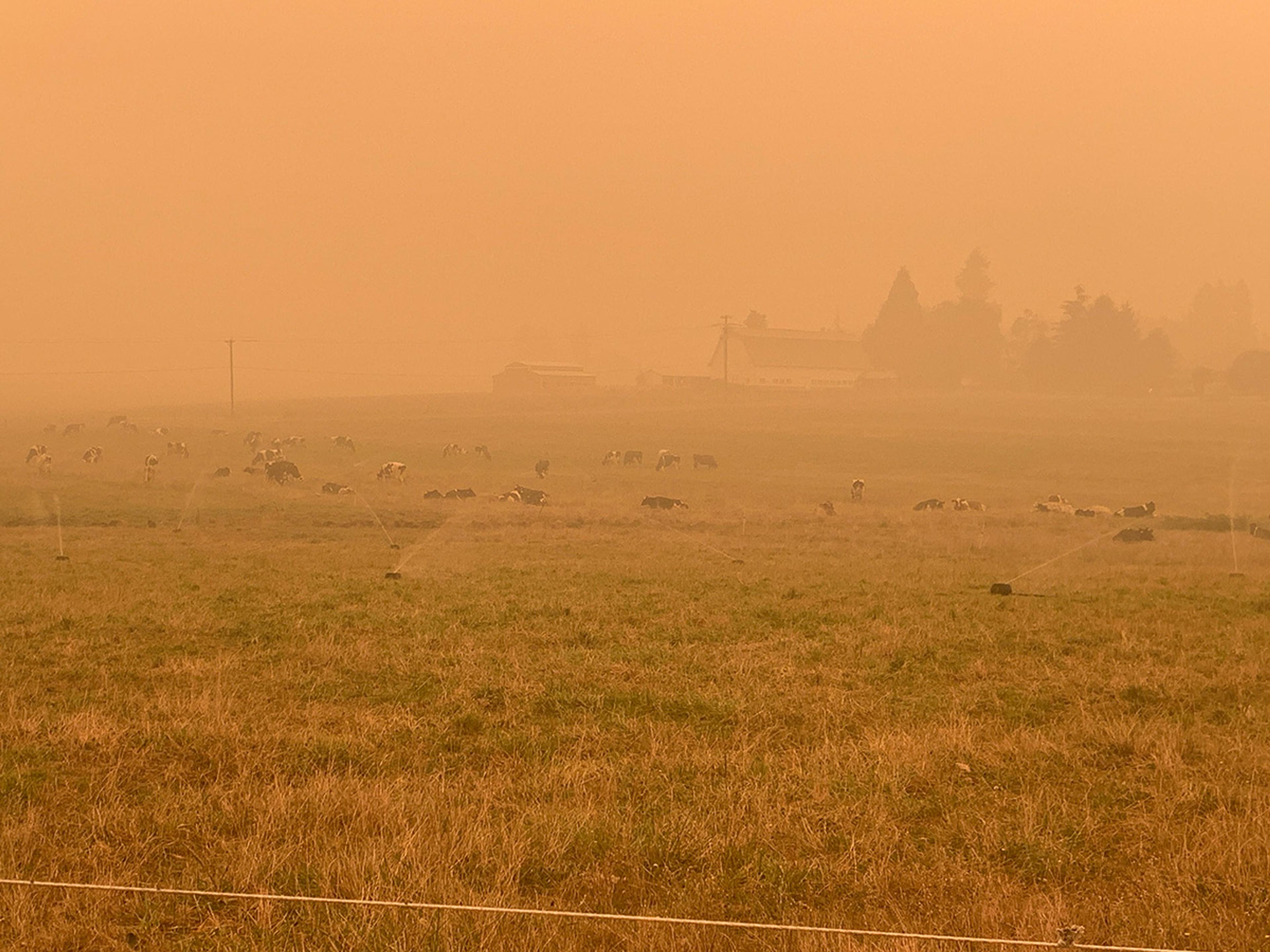
Unprecedented wildfires on the West Coast in 2020 blocked out the sun, stunting plant growth and affecting cows' behaviors. Photo by Melissa Collman.
From Fire to Future
Nearly 3,000 miles away, Jon Bansen of Monmouth, Oregon, was thinking similarly. “It’s just something that you have to spend a lot of time thinking about—what makes ecological sense, and what makes sense for the cows?”
He described the link he saw: “There’s ecological resilience and economic resilience. As long as we can build our ‘bank’ of soil organic matter, that’s really our bank account on our farm, and that’s how we’re able to continue having our farm—by doing things that are good for the environment and that also cut down our costs.”
Despite a similar focus on resilience, Bansen had been facing very different pressures. Instead of the floods affecting Gretebeck and Dobson, Bansen was facing some of the worst fires in Oregon’s history.
“The fires were on the east side of the valley coming off the Cascade Range, heading our way,” Bansen said. “Thankfully we had quite a bit of agricultural ground between us and the fires, but we were absolutely impacted by not seeing the sun for 10 days.”
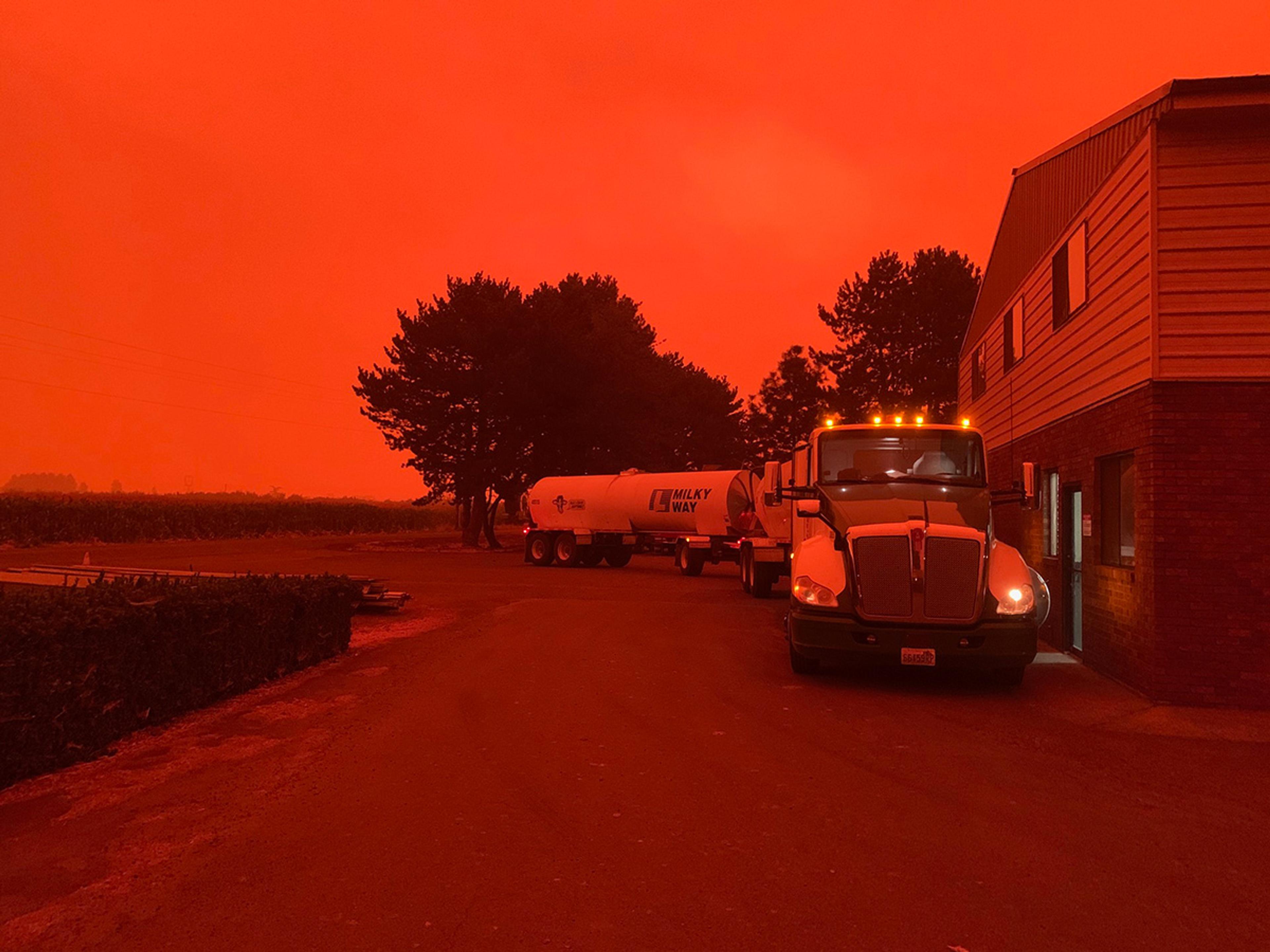
The West Coast fires were so severe, they cast a red tint to the landscape. No filter was used on this photo. Photo by Larry Hansen.
The smoke was so bad it was rated “hazardous” for much of the Willamette Valley where Bansen farms. Choking out the light, the smoke reduced photosynthesis in the pasture, affected the attitude of the cows, and even resulted in unheard-of reports of evergreen trees and bushes dropping leaves. “I’ve lived in the Willamette Valley the last 47 years and such severe fires are a real recent occurrence.”
Despite the pressures of the present, Bansen, like Gretebeck and Dobson, is also looking toward the future. He’s been planting trees in his pastures, which will increase carbon sequestration while providing cooling shade for cows. “We really see that as a necessity with what’s coming with climate change,” he said, crediting his grass-based system for his farm’s resiliency in the face of the changing, drier climate of his local area.
"We see things working in agriculture. We see a path forward."
- -
The Bird’s Eye View
Describing the benefits of grass-based systems, Dr. Randy Jackson of the University of Wisconsin-Madison said, “Not only do well-managed pastures build carbon, which is part of the climate mitigation and stabilization strategy, the soils also hold onto nutrients better and stay in place better. We get less water pollution and less erosion.” Like the farmers I had spoken to, Jackson saw perennial pasture systems as a key tool in the fight against climate change, and he noted that these organic, perennial systems have been shown to attract wildlife back to a farm as well, making them more biodiverse on average than farms that focus on annual crops.
Jake Schmitz, Organic Valley’s west region pool manager, was equally enthusiastic. Donning his climatology hat from a former career, he said, “Grazing is a big mitigation strategy. It’s not just the carbon building in the soil, it’s also cutting the mileage that a cow’s feed travels to zero, so you don’t have any fossil fuels to bring that feed to the cow.”

This scene from an Organic Valley farm shows poor air quality from fires on the West Coast. Photo by Jake Schmitz.
Interestingly, Jackson pointed out that there’s a “social transition cost” when implementing climate-smart farming practices. “It’s hard to be the first person in the neighborhood to do something different.” But organic farmers like Dobson, Gretebeck, Bansen, and so many others are stepping up as leaders on the cutting edge of farm sustainability.
As Bansen put it when describing his tree planting, “The neighbors might wonder what’s going on. It kind of looks ratty, but it’s not a beauty contest. It’s a long game when you’re planting trees. It’s not easy, but if it was easy everyone would do it.” With Bansen and others leading the way and proving these beneficial practices improve farm resilience, hopefully more and more farmers will join in.
Working on the research for this article, I had developed something of a dismal mood from immersing myself in the apocalyptic scientific literature of climate change. Yet the farmers I spoke to were all hopeful. The very people who had experienced the extremes Mother Nature might throw at us, from floods to fires, were also the ones looking forward, helping to find the winding path toward a more sustainable future. Not only are they sharing examples of farming strategies that help to push the climate change needle in the right direction while also creating a healthy, vibrant ecosystem on their farms, their stories may also inspire other farmers through whatever climate challenges come next.
As Dobson eloquently put it, “We see things working in agriculture. We see a path forward.” He encourages us all to think positively about the future and of organic farming’s role in it. “If our little farm can have a microscopic impact on climate change, that’s a great thing, and I’m proud to be a part of it. We see those positive outcomes for the next generation, and that message and impact will spread to others. That’s our goal—to lead by example.”
Dylan Bruce grew up on an organic vegetable farm in Southwest Wisconsin. After working his way through the food system, from farm to restaurant to grocery to procurement, and attending Occidental College, Dylan moved back to his home state to work at the University of Wisconsin-Madison as a research specialist focusing on organic vegetable production. He manages Circadian Organics with his partner producing hemp, fresh market produce, and vegetable seed on his family's farm.
Related Articles
- Tags:
- climate,
- environment,
- pasture & perennial agriculture,
- land stewardship & conservation














